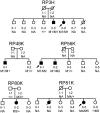Two novel mutations in the EYS gene are possible major causes of autosomal recessive retinitis pigmentosa in the Japanese population
- PMID: 22363543
- PMCID: PMC3281914
- DOI: 10.1371/journal.pone.0031036
Two novel mutations in the EYS gene are possible major causes of autosomal recessive retinitis pigmentosa in the Japanese population
Abstract
Retinitis pigmentosa (RP) is a highly heterogeneous genetic disease including autosomal recessive (ar), autosomal dominant (ad), and X-linked inheritance. Recently, arRP has been associated with mutations in EYS (Eyes shut homolog), which is a major causative gene for this disease. This study was conducted to determine the spectrum and frequency of EYS mutations in 100 Japanese arRP patients. To determine the prevalence of EYS mutations, all EYS exons were screened for mutations by polymerase chain reaction amplification, and sequence analysis was performed. We detected 67 sequence alterations in EYS, of which 21 were novel. Of these, 7 were very likely pathogenic mutations, 6 were possible pathogenic mutations, and 54 were predicted non-pathogenic sequence alterations. The minimum observed prevalence of distinct EYS mutations in our study was 18% (18/100, comprising 9 patients with 2 very likely pathogenic mutations and the remaining 9 with only one such mutation). Among these mutations, 2 novel truncating mutations, c.4957_4958insA (p.S1653KfsX2) and c.8868C>A (p.Y2956X), were identified in 16 patients and accounted for 57.1% (20/35 alleles) of the mutated alleles. Although these 2 truncating mutations were not detected in Japanese patients with adRP or Leber's congenital amaurosis, we detected them in Korean arRP patients. Similar to Japanese arRP results, the c.4957_4958insA mutation was more frequently detected than the c.8868C>A mutation. The 18% estimated prevalence of very likely pathogenic mutations in our study suggests a major involvement of EYS in the pathogenesis of arRP in the Japanese population. Mutation spectrum of EYS in 100 Japanese patients, including 13 distinct very likely and possible pathogenic mutations, was largely different from the previously reported spectrum in patients from non-Asian populations. Screening for c.4957_4958insA and c.8868C>A mutations in the EYS gene may therefore be very effective for the genetic testing and counseling of RP patients in Japan.
Conflict of interest statement
Figures



Similar articles
-
Five major sequence variants and copy number variants in the EYS gene account for one-third of Japanese patients with autosomal recessive and simplex retinitis pigmentosa.Mol Vis. 2019 Nov 15;25:766-779. eCollection 2019. Mol Vis. 2019. PMID: 31814702 Free PMC article.
-
Identification of a novel homozygous nonsense mutation in EYS in a Chinese family with autosomal recessive retinitis pigmentosa.BMC Med Genet. 2010 Aug 10;11:121. doi: 10.1186/1471-2350-11-121. BMC Med Genet. 2010. PMID: 20696082 Free PMC article.
-
Missense mutations at homologous positions in the fourth and fifth laminin A G-like domains of eyes shut homolog cause autosomal recessive retinitis pigmentosa.Mol Vis. 2010 Dec 15;16:2753-9. Mol Vis. 2010. PMID: 21179430 Free PMC article.
-
Ocular genetics in the Japanese population.Jpn J Ophthalmol. 2024 Sep;68(5):401-418. doi: 10.1007/s10384-024-01109-8. Epub 2024 Sep 14. Jpn J Ophthalmol. 2024. PMID: 39271608 Free PMC article. Review.
-
Genes and Mutations Causing Autosomal Dominant Retinitis Pigmentosa.Cold Spring Harb Perspect Med. 2014 Oct 10;5(10):a017129. doi: 10.1101/cshperspect.a017129. Cold Spring Harb Perspect Med. 2014. PMID: 25304133 Free PMC article. Review.
Cited by
-
Whole exome sequencing to identify genetic markers for trastuzumab-induced cardiotoxicity.Cancer Sci. 2018 Feb;109(2):446-452. doi: 10.1111/cas.13471. Epub 2018 Jan 24. Cancer Sci. 2018. PMID: 29247589 Free PMC article.
-
Targeted next-generation sequencing extends the phenotypic and mutational spectrums for EYS mutations.Mol Vis. 2016 Jun 16;22:646-57. eCollection 2016. Mol Vis. 2016. PMID: 27375351 Free PMC article.
-
Evaluation of photoreceptor-directed fibroblasts derived from retinitis pigmentosa patients with defects in the EYS gene: a possible cost-effective cellular model for mechanism-oriented drug.Stem Cell Res Ther. 2022 Apr 11;13(1):157. doi: 10.1186/s13287-022-02827-x. Stem Cell Res Ther. 2022. PMID: 35410372 Free PMC article.
-
Retinal structure in Leber's congenital amaurosis caused by RPGRIP1 mutations.Hum Genome Var. 2019 Jun 27;6:32. doi: 10.1038/s41439-019-0064-8. eCollection 2019. Hum Genome Var. 2019. PMID: 31666973 Free PMC article.
-
Whole-exome sequencing identified genes known to be responsible for retinitis pigmentosa in 28 Chinese families.Mol Vis. 2022 Jun 6;28:96-113. eCollection 2022. Mol Vis. 2022. PMID: 35814500 Free PMC article.
References
-
- Abd El-Aziz MM, O'Driscoll CA, Kaye RS, Barragán I, El-Ashry MF, et al. Identification of novel mutations in the ortholog of Drosophila eyes shut gene (EYS) causing autosomal recessive retinitis pigmentosa. Invest Ophthalmol Vis Sci. 2010;51:4266–4272. - PubMed
-
- Audo I, Sahel JA, Mohand-Saïd S, Lancelot ME, Antonio A, et al. EYS is a major gene for rod-cone dystrophies in France. Hum Mutat. 2010;31:E1406–1435. - PubMed
Publication types
MeSH terms
Substances
LinkOut - more resources
Full Text Sources
Other Literature Sources
Molecular Biology Databases
Research Materials

